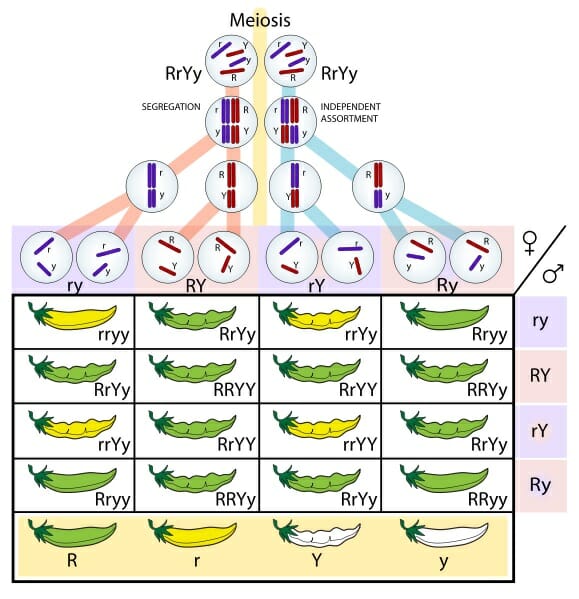The Austrian monk Gregor Mendel conducted revolutionary experiments with pea plants in the early 1800s showing the existence of traits (he called them “factors”) that offspring inherit from their parents. His work culminates in the three principles of Mendelian inheritance; the law of segregation, the law of independent assortment, and the law of dominance.
The law of dominance says dominant alleles (a variation of a gene) are always expressed in the phenotype (appearance) of an organism because they mask the effects of recessive alleles. Recessive traits are seen only when the offspring inherit the recessive allele for the trait from both parents. The other two laws of Mendelian inheritance deal with creating gametes and the independent nature of their inheritance.
Law of Segregation
Meiosis is the process of creating sperm and egg gametes. Each gamete contains half (haploid) the number of chromosomes an individual needs, so fertilization results in the offspring receiving one allele for a trait from each parent. The law of segregation states that the parental genes must separate randomly and equally into gametes during meiosis so there is an equal chance of the offspring inheriting either allele. No allele is favored or has an advantage over another.
Mendel observed segregation in his experiments when parental pea plants with two traits produced offspring that all expressed the dominant traits, but their offspring expressed dominant and recessive traits in a 3:1 ratio. As part of this work, Mendel discovered that he could predict the color and height of the offspring.
Law of Independent Assortment
This law says inheriting an allele has nothing to do with inheriting an allele for any other trait. The alleles from parents are passed on independently to the offspring. After fertilization, the resulting zygote(s) can end up with any combination of chromosomes from the parents and all the possible combinations occur with equal frequency.
Like segregation, independent assortment occurs during meiosis, specifically in prophase I when the chromosomes line up in random orientation along the metaphase plate. Crossing over, the exchange and recombination of genetic information between chromosomes also occurs in prophase I and adds to the genetic diversity of the offspring.
The image above illustrates the laws of Mendelian inheritance. The segregation of gametes and the independent assortment of traits occurs in meiosis. As a result, each offspring ends up with the full number of chromosomes containing randomly assorted alleles from each parent.
References
- Mendelian inheritance. (2018, May 5). In Wikipedia. Retrieved from https://en.wikipedia.org/w/index.php?title=Mendelian_inheritance&oldid=839776145
- OpenStax College. (2018). Anatomy & Physiology. Houston, TX. OpenStax CNX. Retrieved from http://cnx.org/contents/14fb4ad7-39a1-4eee-ab6e-3ef2482e3e22@8.119

